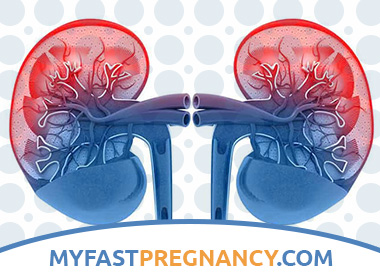What is Acute Jade Syndrome?
Acute nephritic syndrome is characterized by the sudden onset of hematuria and proteinuria, signs of azotemia (a decrease in glomerular filtration rate), a delay in the body’s salts and water, and arterial hypertension.
Causes of Acute Jade Syndrome
- Infections;
- Post-streptococcal glomerulonephritis;
- Non-post-streptococcal glomerulonephritis;
- Bacterial: infectious endocarditis, sepsis, pneumococcal pneumonia, typhoid fever, meningococcal infection;
- Viral: hepatitis B, infectious mononucleosis, mumps, chickenpox, infections caused by Coxsackie viruses, ECHO;
- Other forms of post-infectious glomerulonephitis develop against the background of a current infection, they have a shorter latent period. Nephritis is difficult to diagnose with subacute infectious endocarditis: a variety of kidney lesions, systemic manifestations can mimic other diseases (for example, SLE or polyarteritis nodosa), blood can be sterile;
- Systemic diseases: SLE, vasculitis, Schönlein-Genoch disease, hereditary pulmonary-renal syndrome;
- Primary kidney diseases: mesangioproliferative glomerulonephritis, Berger disease, mesangiocapillary glomerulonephritis;
- Mixed causes: Hyena-Barre syndrome, radiation, administration of sera and vaccines.
Pathogenesis during Acute Jade Syndrome
The model of acute nephritic syndrome is post-streptococcal glomerulonephritis. It is necessary to have a focus of infection (upper respiratory tract, skin, middle ear) caused by beta-hemolytic group A streptococcus (strains 1, 4, 12, 29). AT is produced against streptococcus antigens (for example, M-protein of the cell wall), Ag-AT complexes are deposited in the walls of the glomerular capillaries, activating the complement system, and lead to immune inflammation and damage to kidney tissue.
Pathomorphology
- Diffuse proliferative endocapillary glomerulonephritis;
- Glomerular infiltration with neutrophils and monocytes;
- The walls of the glomerular capillaries are thinned and fragile;
- Discrete deposits of protein (electron microscopy – electron-dense deposits) protruding from the outer surface of the capillary wall into the lumen of the capsule and corresponding to those observed by electron microscopy and electron-dense deposits;
- Segment extracapillary proliferation (half moon) is detected in several glomeruli, diffuse formation of half moon is uncharacteristic;
- In the lumens of the distal tubules, red blood cell cylinders are detected;
- Granular deposits of IgG in the peripheral loops of capillaries and in the mesangium, accompanied by deposits of the complement component C3 and properdine and, less commonly, deposits of Clq and C4.
Symptoms of Acute Jade Syndrome
The disease manifests itself 1-6 weeks after streptococcal infection.
Classic signs of acute jade:
- Hematuria (100%). Macrohematuria occurs in 30% of cases (urine is the color of meat slops);
- Edema (85%). The most characteristic swelling of the face (especially the eyelids) from the second half of the day, as well as feet and legs in the evening;
- Arterial hypertension (82%);
- Hypocomplementemia (SZ content) – 83% of cases;
- Oligoanuria (52%) in combination with thirst.
Other signs:
- An increase in body temperature (rarely);
- Anorexia, nausea, vomiting, headache, weakness;
- Pain in the lower back;
- Abdominal pain;
- Weight gain;
- Signs of infectious diseases of the respiratory tract (including acute tonsillitis, pharyngitis);
- Signs of scarlet fever;
- Signs of impetigo.
Diagnosis of Acute Jade Syndrome
Laboratory data:
- Oliguria;
- Proteinuria from 0.5 to 2 g / m2 / day;
- The urinary sediment contains red blood cells, white blood cells and cells of the renal tubules, cylinders;
- Increase in the titer of AT (anti-streptolysin O, antistreptokinase, antigialuronidase, antideoxyribonuclease B);
- Decrease in hemolytic activity of the complement component of CH50, as well as its components S3, C4 in blood serum in the active phase of the disease. With post-streptococcal glomerulonephritis, they return to the initial level after 6-8 weeks, with membrane-proliferative glomerulonephritis, the changes remain for life;
- >Ultrasound determines the size of the kidney (not changed or increased) and glomerular filtration rate.
Acute Jade Syndrome Treatment
- In most cases, there is no specific treatment;
- Diet No. 7a – protein restriction, salt is limited in edema, arterial hypertension;
- Immunosuppressants and glucocorticoids are ineffective, the latter can even worsen the condition.
With a bacterial infection, antibiotics. To reduce the BCC – diuretics (thiazides, loop diuretics). Arterial hypertension treatment – ACE inhibitors, calcium channel blockers, diuretics. In renal failure, dialysis and kidney transplantation.
Prevention of Acute Jade Syndrome
Immunocomplex acute nephritic syndrome (for example, post-streptococcal glomerulonephritis) has a good prognosis for minor kidney damage and elimination of the source of antigenemia. In 1% of children and 10% of adults, acute nephritic syndrome transforms into rapidly progressive glomerulonephritis.
Deviations in urinalysis (proteinuria and hematuria) are detected within a few years after the disease, sometimes the disease slowly progresses to chronic renal failure. Glomerulonephritis with infection of a vascular prosthesis has a good prognosis if the infection is eliminated (usually Staphylococcus epidermidis) – antibiotic therapy and removal of the prosthesis.

